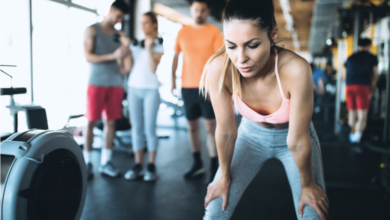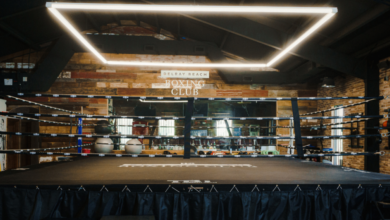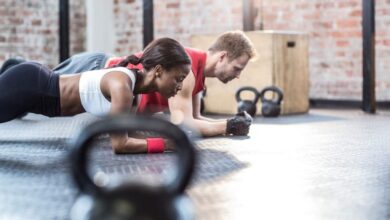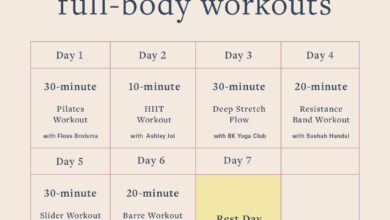Your 10 Minute No Equipment Core Workout
Your 10 minute no equipment core workout is a fantastic way to strengthen your core without needing any fancy gym equipment. It’s a quick and effective routine that can be done anywhere, anytime, making it perfect for busy schedules.
This workout targets all the major muscle groups in your core, including your abs, obliques, and lower back, helping you achieve a stronger, more stable body.
This workout is designed for all fitness levels. You can easily modify the exercises to suit your abilities, making it accessible to everyone. Whether you’re a seasoned athlete or just starting your fitness journey, this routine will challenge you and help you reach your fitness goals.
Introduction
A strong core is essential for overall fitness and well-being. It provides stability for your body, improves posture, and helps you perform everyday activities with ease. A 10-minute no-equipment workout is a practical option for those who are short on time or lack access to a gym.
Benefits of Core Strength Training
Core strength training is beneficial for many reasons. It improves posture, balance, and coordination. It also reduces the risk of injuries, enhances athletic performance, and improves overall strength and stability.
Workout Structure
This workout will consist of five exercises, each performed for 30 seconds followed by a 15-second rest. You will complete two rounds of the circuit, with a 60-second rest between rounds.
Warm-up
A proper warm-up is crucial before any workout, especially a core-focused one. It prepares your muscles for the demands of exercise, increasing blood flow, flexibility, and range of motion. This helps prevent injuries and enhances your workout performance.
Dynamic Warm-up Routine
Dynamic stretching involves controlled movements that warm up your muscles and joints. This routine includes exercises that target the major muscle groups used in the core workout.
- Arm Circles: Stand with feet shoulder-width apart. Rotate your arms forward in a circular motion for 10-15 repetitions. Then, reverse the direction and rotate backward for the same number of repetitions. This warms up the shoulders and upper back.
- Leg Swings: Stand with feet shoulder-width apart. Swing one leg forward and backward, keeping the other leg straight. Repeat for 10-15 repetitions on each leg. This warms up the hips, hamstrings, and quadriceps.
- Torso Twists: Stand with feet shoulder-width apart. Slowly rotate your torso from side to side, keeping your core engaged. Repeat for 10-15 repetitions on each side. This warms up the obliques and core muscles.
Workout Routine: Your 10 Minute No Equipment Core Workout
Now that you’ve warmed up, it’s time to get into the core workout. This routine focuses on engaging your abdominal muscles, lower back, and obliques. You’ll perform a series of exercises, each targeting different areas of your core.
Core Exercises
This workout consists of five core exercises, each designed to challenge your core strength and stability.
| Exercise | Sets | Reps | Rest |
|---|---|---|---|
| Plank | 3 | 30-60 seconds | 30-60 seconds |
| Mountain Climbers | 3 | 15-20 reps per leg | 30 seconds |
| Bicycle Crunches | 3 | 15-20 reps per side | 30 seconds |
| Russian Twists | 3 | 15-20 reps per side | 30 seconds |
| Leg Raises | 3 | 15-20 reps | 30 seconds |
Remember to maintain proper form throughout the workout. Focus on engaging your core and breathing deeply throughout each exercise.
My 10-minute no-equipment core workout is a great way to build strength and definition, even if you’re short on time. But like any routine, it’s important to keep things fresh to avoid plateaus. That’s why I recommend checking out this awesome article on 6 ways to avoid workout plateaus and consistently progress.
The tips in this article will help you mix things up and continue seeing results with your core workout, so you can stay motivated and strong!
Plank
The plank is a static exercise that strengthens your entire core. It works your abs, obliques, lower back, and shoulders. * How to do it:
Start in a push-up position, with your forearms on the ground and your body in a straight line from head to heels.
Engage your core, squeezing your glutes and keeping your back flat.
Hold this position for 30-60 seconds.
* Variations:
Forearm Plank This is the standard plank variation.
High Plank Start in a push-up position with your hands shoulder-width apart.
Side Plank Lie on your side with your forearm on the ground and your body in a straight line. Engage your core and lift your hips off the ground.
Mountain Climbers
Mountain climbers are a dynamic exercise that targets your abs, obliques, and quads. * How to do it:
Start in a plank position.
Bring one knee towards your chest, then quickly switch legs, bringing the other knee towards your chest.
Continue alternating legs, keeping your core engaged and your back straight.
* Variations:
Standard Mountain Climbers This is the basic version of the exercise.
Lateral Mountain Climbers Move your knees out to the sides instead of forward.
Reverse Mountain Climbers
My 10-minute no-equipment core workout is a killer way to sculpt those abs, but it’s equally important to give your body a break. That’s where recovery days come in. Check out this article on 5 great things about recovery days to learn how those rest days actually help you get stronger.
Then, get back to those planks and crunches – you’ll be glad you did!
Bicycle Crunches
Bicycle crunches are a great exercise for targeting your obliques. * How to do it:
Lie on your back with your knees bent and your feet flat on the ground.
Place your hands behind your head, with your elbows out to the sides.
Bring your right elbow towards your left knee, and extend your right leg straight out.
Repeat on the other side, bringing your left elbow towards your right knee and extending your left leg.
* Variations:
Standard Bicycle Crunches This is the basic version of the exercise.
Elevated Bicycle Crunches Perform the exercise with your legs elevated on a bench or chair.
Weighted Bicycle Crunches Hold a light weight in each hand to increase the challenge.
Russian Twists
Russian twists are a great exercise for working your obliques and abs. * How to do it:
Sit on the ground with your knees bent and your feet flat on the ground.
Lean back slightly, engaging your core.
Twist your torso to the right, then to the left, keeping your core engaged.
* Variations:
Standard Russian Twists This is the basic version of the exercise.
Weighted Russian Twists Hold a weight in each hand to increase the challenge.
Medicine Ball Russian Twists Use a medicine ball to add resistance.
Leg Raises
Leg raises are a great exercise for targeting your lower abs. * How to do it:
Lie on your back with your knees bent and your feet flat on the ground.
Place your hands behind your head, with your elbows out to the sides.
Lift your legs straight up towards the ceiling, keeping your core engaged.
Lower your legs back down to the starting position.
* Variations:
Standard Leg Raises This is the basic version of the exercise.
Bent Knee Leg Raises Keep your knees bent throughout the exercise.
Weighted Leg Raises
My 10-minute no-equipment core workout is a great way to strengthen your midsection, and it can even help improve your VO2 max! VO2 max is a measure of your body’s ability to use oxygen, and it’s crucial for endurance performance.
To boost your VO2 max, you need to challenge your cardiovascular system, which you can do by incorporating high-intensity interval training (HIIT) into your workouts. Learn more about what is VO2 max and how to improve it and get ready to see some serious results in your 10-minute core routine!
Cool-down
Cooling down after your core workout is just as important as the workout itself. It helps your body recover, reduces muscle soreness, and prevents injuries.
Static Stretching
Static stretching involves holding a stretch for a period of time, typically 15-30 seconds. This helps to increase flexibility and range of motion. Here are a few static stretches you can do after your core workout:
- Quadriceps Stretch: Stand with your feet hip-width apart. Bend your right knee and grab your right foot with your right hand. Gently pull your heel towards your buttock until you feel a stretch in the front of your thigh. Hold for 15-30 seconds and repeat on the other side.
- Hamstring Stretch: Sit on the floor with your legs extended in front of you. Reach towards your toes, keeping your back straight. Hold for 15-30 seconds.
- Chest Stretch: Stand with your feet shoulder-width apart. Interlock your fingers behind your back and lift your arms up towards the ceiling. Hold for 15-30 seconds.
Tips and Considerations
This core workout is designed to be effective, but to maximize your results and get the most out of your effort, it’s crucial to follow these tips and keep some important considerations in mind. By understanding these key points, you can enhance your workout experience and achieve your fitness goals more efficiently.
Consistency and Proper Form
Consistency is key to seeing results from any workout routine. Aim to complete this core workout 2-3 times per week, allowing for rest days between sessions. This allows your muscles to recover and rebuild, leading to greater strength and endurance over time.Just as important as consistency is maintaining proper form.
This ensures you’re targeting the right muscles and reducing the risk of injury. If you’re unsure about proper form, consult with a fitness professional or watch videos demonstrating the exercises.
Focus on controlled movements and engaging your core throughout each exercise.
Modifying the Workout for Different Fitness Levels
This core workout can be modified to suit different fitness levels. For beginners, start with fewer repetitions or hold each exercise for a shorter duration. As you gain strength and stamina, you can gradually increase the intensity and duration.For more advanced exercisers, consider adding weights or resistance bands to increase the challenge.
You can also try holding each exercise for a longer duration or performing more repetitions.
- Beginners:Reduce the number of repetitions per exercise or hold each exercise for a shorter duration. For example, instead of 15 repetitions, start with 10.
- Intermediate:Maintain the recommended number of repetitions and hold each exercise for the specified duration. Consider adding a light weight or resistance band for an extra challenge.
- Advanced:Increase the number of repetitions per exercise, hold each exercise for a longer duration, or incorporate heavier weights or resistance bands.
Listening to Your Body, Your 10 minute no equipment core workout
While pushing yourself is important for progress, it’s crucial to listen to your body. If you feel pain, stop the exercise immediately and rest. Pain is your body’s way of telling you something is wrong, and ignoring it can lead to injury.If you’re new to exercise or have any underlying health conditions, consult with your doctor before starting a new workout routine.
Ultimate Conclusion
A strong core is essential for overall health and well-being. By incorporating this 10-minute no-equipment core workout into your routine, you can reap the benefits of a stronger core, improved posture, and reduced risk of injuries. Remember to listen to your body, focus on proper form, and enjoy the journey of getting stronger.
So, grab a mat, find a quiet space, and get ready to unleash your inner core strength!






